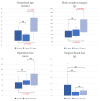Sutureless Loop Enterostomy in Very Low and Extremely Low Birth Weight Infants
- PMID: 39717300
- PMCID: PMC11665255
- DOI: 10.7759/cureus.74296
Sutureless Loop Enterostomy in Very Low and Extremely Low Birth Weight Infants
Abstract
Introduction Sutureless enterostomy is used as an effective technique for constructing an enterostomy in very low and extremely low birth weight infants in Japan. Sutureless enterostomy is a separate type of enterostomy procedure for low birth weight infants. We adapted this technique and developed sutureless loop enterostomy (SLE), an approach without a skin bridge in which the intestinal wall is not sutured to the abdominal wall. This study aimed to compare SLE outcomes with those of sutureless enterostomy (SE) and the conventional procedure (C). Methods We retrospectively reviewed clinical records of 32 very low or extremely low birth weight infants who underwent enterostomy and classified the infants into three groups according to the procedure: SLE, SE, and C. We compared surgery-related items and enterostomy-related complications between the three groups. Results We found no significant differences in sex, age at surgery, or surgical blood loss. The operation time was significantly shorter in the SLE group than in the C group (P < 0.05). The number of postoperative complications was not significantly different in the SLE group compared with the other two groups. Conclusion Sutureless loop enterostomy is an effective, safe procedure for enterostomy in very low and extremely low birth weight infants.
Keywords: extremely low birth weight infants; focal intestinal perforation; meconium-related ileus; necrotizing enterocolitis; very low birth weight infants.
Copyright © 2024, Muta et al.
Conflict of interest statement
Human subjects: Consent for treatment and open access publication was obtained or waived by all participants in this study. Research Ethics Committee of Saitama Medical Center, Saitama Medical University issued approval SMC2021-140. Animal subjects: All authors have confirmed that this study did not involve animal subjects or tissue. Conflicts of interest: In compliance with the ICMJE uniform disclosure form, all authors declare the following: Payment/services info: All authors have declared that no financial support was received from any organization for the submitted work. Financial relationships: All authors have declared that they have no financial relationships at present or within the previous three years with any organizations that might have an interest in the submitted work. Other relationships: All authors have declared that there are no other relationships or activities that could appear to have influenced the submitted work.
Figures




Similar articles
-
Sutureless enterostomy for extremely low birth weight infants.J Pediatr Surg. 2017 Nov;52(11):1873-1877. doi: 10.1016/j.jpedsurg.2017.08.009. Epub 2017 Aug 15. J Pediatr Surg. 2017. PMID: 28866372
-
Sutured Versus Sutureless Enterostomies: An Alternative Technique in Critically Sick Neonates.Cureus. 2022 Apr 12;14(4):e24057. doi: 10.7759/cureus.24057. eCollection 2022 Apr. Cureus. 2022. PMID: 35573560 Free PMC article.
-
A sutureless technique using cyanoacrylate adhesives when creating a stoma for extremely low birth weight infants.Springerplus. 2016 Feb 27;5:189. doi: 10.1186/s40064-016-1852-y. eCollection 2016. Springerplus. 2016. PMID: 27026885 Free PMC article.
-
Gastrointestinal perforation in extremely low birth weight infants: A single center retrospective study in China.Pediatr Neonatol. 2024 Mar;65(2):111-116. doi: 10.1016/j.pedneo.2023.11.002. Epub 2023 Dec 9. Pediatr Neonatol. 2024. PMID: 38114414 Review.
-
Surgical management of extremely low birth weight infants with neonatal bowel perforation: a single-center experience and a review of the literature.Neonatology. 2012;101(4):285-92. doi: 10.1159/000335325. Epub 2012 Jan 27. Neonatology. 2012. PMID: 22286302 Review.
References
-
- Surgical management of extremely low birth weight infants with neonatal bowel perforation: a single-center experience and a review of the literature. Eicher C, Seitz G, Bevot A, et al. Neonatology. 2012;101:285–292. - PubMed
-
- Colostomy complications in children. An analysis of 146 cases. Mollitt DL, Malangoni MA, Ballantine TV, Grosfeld JL. Arch Surg. 1980;115:455–458. - PubMed
-
- New technique for enterostomy of extremely low-birth-weight infants--intestinal anchoring with gauze. Kondo K, Chijiiwa K, Mukai M, et al. J Pediatr Surg. 2008;43:1755–1760. - PubMed
-
- Stomal complications in the newborn with necrotizing enterocolitis. Aguayo P, Fraser JD, Sharp S, St Peter SD, Ostlie DJ. J Surg Res. 2009;157:275–278. - PubMed
LinkOut - more resources
Full Text Sources
